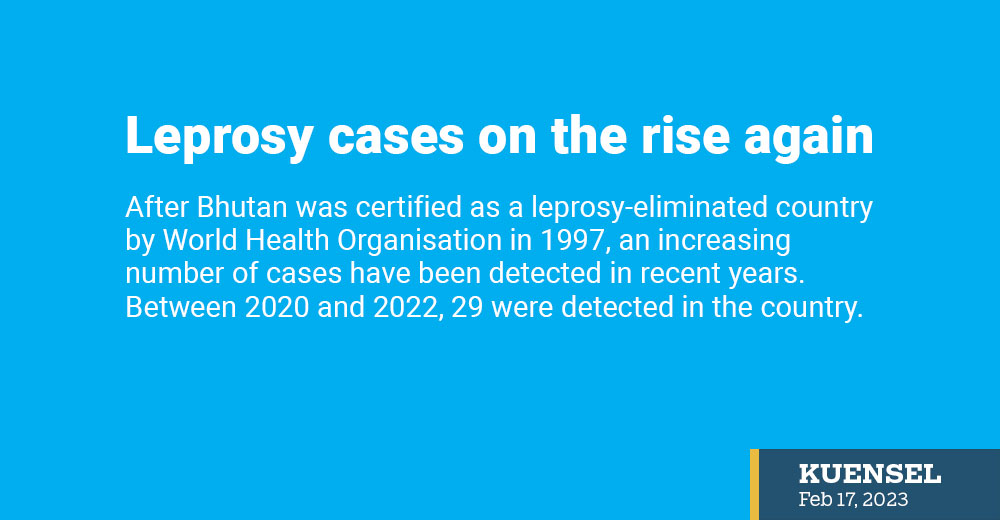Nima Wangdi
After Bhutan was certified as a leprosy-eliminated country by World Health Organisation in 1997, an increasing number of cases have been detected in recent years.
Between 2020 and 2022, 29 were detected in the country.
There were nine cases detected in 2020, one each in Zhemgang, Trashigang, Lhuentse, Punakha, Mongar, and two from Thimphu. Two more cases were also detected among the foreign nationals working in Bhutan according to Gidakom hospital’s record.
In 2021, 17 new cases were detected. There was one each from lunana in Gasa, Drametse in Mongar, Gangzur in Lhuentse, Bidung in Trashigang, Kazhi in Wangdue, Drakteng in Trongsa, Umling in Sarpang, Guma in Punakha, Sershong in Sarpang, and Phuntsholing in Chukha.
Thimphu and Metsho in Lhuntse had two each while Wamrong in Trashigang had three.
However, only three cases were detected in 2022, one each from Metsho in Lhuentse and Dungmin in Pemagatshel, and Dopshari in Paro.
TB and Leprosy In-charge, Senior Health Assistant Budhi Man Subba said more cases were detected in 2021 because they carried out contact-tracing actively after the lockdown relaxation. He said there are other challenges like a shortage of human resources and budget.
There are three patients being treated at Gidakom hospital in Thimphu.
To control the number of cases, the hospital will carry out “focal surveys”. The family members of the patient need to be tested for leprosy for around 10 years every year.
A medical doctor said there are chances that the doctors could sometimes mistake leprosy symptoms for other diseases as it is a forgotten disease. “Active surveillance is crucial for detecting the disease on time,”
Going by the definition, WHO declares a disease eliminated if the prevalence rate is less than one per 10,000.
Bhutan started multi-drug therapy in the 90s, which has produced a dramatic result of elimination and it will take time to eradicate the disease since the incubation period is long according to health professionals.
The incubation period ranges from nine to 30 years.
Leprosy is a contagious disease caused by bacteria called Mycobacterium Leprae.
The symptoms include red patches on the skin with lost or impaired sensation to heat and cold, and painless ulcers on hands and feet, among others.
Causes and symptoms
Health officials said that leprosy is a chronic infection of the skin and peripheral nerves caused by the obligate intracellular bacterium, mycobacterium leprae, also known as “Hansen’s Bacillus”. Similar to Tuberculosis, leprosy bacilli are mainly transmitted through infectious droplets that are spread by an infectious individual through coughing and sneezing.
Symptoms include pale or reddish patches on the skin with lost or impaired sensation for heat, cold, fine touch and pain on pinprick besides numbness or tingling and weakness of hands and feet, and painless ulcers in the soles and palms.
Treatment
Health officials said leprosy patients are provided Multi-drug Treatment (MDT), which is the only chemotherapy that kills the bacilli. A high proportion of bacilli are killed within a few days after initiation of the treatment.
“MDT contains a combination of three drugs. The treatment with MDT is very effective,” a health expert said. Multi-bacillary patients are treated for 12 months and paucibacillary (PB) patients are treated for six months.


